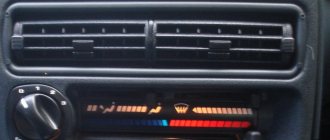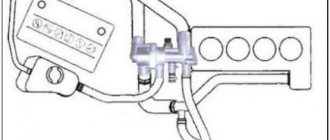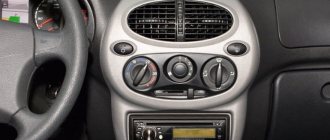If there is quite a strong frost outside, and the interior of your car does not warm up in any way, you should pay attention to the serviceability of the engine cooling system, since the performance of the Lada Granta stove depends on it.
- Coolant. The condition of your car’s coolant should be constantly monitored, and not only when the heater in the Lada Granta is not heating well. The normal coolant level should be kept between about and the “maximum” of the corresponding tank.
If the level is too low, problems with the sealing of the entire cooling system may occur. As a result, the pressure inside the system decreases significantly. If this problem is not resolved, then there is no point in hoping that the stove in the Lada Granta will work well.
- Thermostat. It may happen that in the thermostat position, in which the coolant circulates in a large circle, the thermostat valves become stuck. This is the reason that in the cold season the coolant is simply not able to warm up to normal temperature and ensure good operation of the stove.
In order to be convinced of the presence of this particular problem, it is necessary, no matter how strange it may sound, to get into a traffic jam.
If the problem is really in the thermostat, then the car will literally begin to overheat in a matter of minutes. And when driving along the highway at a decent speed, the engine, on the contrary, will cool too quickly.
- Air temperature regulator damper. If the stove in your Lada Granta does not work well enough, perhaps the reason lies in the functioning of the air temperature regulator damper. And all because the position of the damper directly determines the intensity of the air flow that will pass through the heater radiator, as well as the amount that will enter the car interior, bypassing the radiator.
- Heater fan and fuse. It is necessary to monitor very carefully whether the heater fan starts working. If this does not happen, you should check the functionality of the fuse called 30A. It is green in color and indexed F4, located in the additional concentration of power fuses, which is under the hood, not far from the expansion tank.
If it turns out that the fuse is in working order, most likely the stove is not working well or not working at all due to a malfunction of the electric fan motor. You can get to it only through a special hole, which will become accessible after the glove compartment lid is removed. In the case when the fan operates at its maximum speed, but the air still does not flow well into the cabin, the problem lies in the contamination of the cabin filter, which should be thoroughly cleaned, or even better, replaced with a new one.
- Resistor block. If the heater fan of your Lada Granta works exclusively at the fourth speed, and at the first three completely refuses to show signs of life, it’s time to pay attention to the resistor unit.
Unfortunately, this part cannot be repaired, so if a malfunction is detected, it will have to be completely replaced. You can get to the resistor block in the same way as to the electric motor.
If a car is, in fact, a second home for you, but only on “wheels,” then, of course, you will not give up on the problem of poor interior heating. Nobody wants to be in a “metal freezing trap” in winter. But this is exactly how you can view a car in which the stove refuses to function. The masters know exactly what to do in this case, but for such knowledge, and even more so for their actions, you will have to pay by taking several large bills out of your wallet with great sadness. We suggest that you do not follow traditional methods of solving the problem, but roll up your sleeves to independently find and eliminate the reasons why the stove in your Lada Granta does not work.
If the heater on your car stops working, you need to check the serviceability of not only the heater itself, but also all other devices included in the heating and cooling system. The failure of any link provokes a failure of the entire system or its individual part. Experienced car owners recommend not to wait for a problem to arise, but to periodically arrange preventive examinations for your “iron friend”, then you can prevent undesirable consequences.
If the stove begins to supply only cold air into the cabin, the following may be the trigger:
- insufficient coolant level;
- poor thermostat performance;
- the damper does not close completely;
- a broken fan;
- burnt fuses or resistor.
It is for this reason that it is useful to have your entire heating and cooling system inspected.
Restoring the heater
First you need to check the coolant level. It should not be lower than what is indicated by the manufacturer. The manufacturer indicates two critical levels on the expansion tank: maximum and minimum. The liquid should not go beyond these two boundary states. A low level of coolant provokes a decrease in pressure inside the cooling system, in this case it is very stupid to hope for excellent operation of the stove, and accordingly, there is no point in counting on the fact that the cabin will become warm.
As soon as the level drops, the owner must top up the coolant used. Mixing antifreeze and antifreeze should not be allowed. Otherwise, a chemical reaction may occur, causing the radiator to become clogged with sediment. An excessively dirty radiator will interfere with the normal operation of the stove.
If you actually find a dirty radiator, we recommend that you wash it. You can purchase special chemicals, pour them inside the device, and also clean the upper surface of the radiator using such products. Often drivers, noticing a radiator leak, decide to quickly solve the problem. To do this, they go to an auto store where they purchase sealant. Of course, the sealant can be considered as a real “savior” if there is a leak along the way. However, it must be used if other methods of eliminating leaks are not available. The sealant plugs the holes, stopping the leak, but at the same time it also clogs important parts of the radiator, as a result of which its performance decreases.
Sometimes the thermostat fails, or rather, its valve begins to work incorrectly. For this reason, the circulation of the liquid is disrupted; accordingly, it cannot warm up normally and ensure the successful supply of warm air to the car interior. It’s easy to check the version of a failed thermostat. Start the stove and continue driving along the route you need. At this moment, if the thermostat is faulty, the stove will “go on strike” and refuse to heat the interior of your Lada Granta. As soon as you get stuck in a traffic jam or stop on purpose, as if being in forced downtime, you will notice that your stove will simply begin to “boil”. However, having resumed movement, the stove will again begin to cool quickly. Having noticed such “oddities” in your heater, you can be absolutely sure that you need to change or repair the thermostat.
Thermostat has failed
Another reason when the stove on a Lada Grant does not heat well is that the thermostat has broken. How to determine a malfunction, by what signs? When the engine is warm, the antifreeze does not warm up above 76 degrees when the air intake damper is open. In this case, only a complete replacement of the thermostat will help.
The standard thermostat installed on the Lada Grant opens at a temperature of 85 degrees. In automotive stores you can find thermostats that are designed to operate at a temperature of 92 degrees. Therefore, according to theory, the interior of the Lada Granta should become warmer in winter.
Air in the system
What to do about airing in the system?
- Find a hill with a slope of at least 30%.
- Place the Lada Granta on it with the front facing up.
- Warm up the engine to operating temperature (approximately 85 degrees).
- Squeeze the hoses vigorously until air leaves the system.
As a result, the car should become warmer.
Heater radiator: responsible for heating the interior
It’s hard to imagine a modern car without a standard set of devices and options, thanks to which driving the vehicle becomes as convenient as possible, and staying in the cabin is comfortable and safe. The functions of maintaining a favorable temperature regime in the car are assigned to the heating, air conditioning and ventilation system, which, depending on the situation, can heat, ventilate or cool the air in the cabin. At the same time, one of the key components of the heating system is the stove, which includes a radiator that acts as a heat exchanger. The air entering the car interior is heated by the radiator, and it is heated by the liquid that cools the engine.
"Lada Granta" is equipped with a large number of options, thanks to which driving the vehicle becomes quite convenient
Failure of the cylinder head gasket
You need to understand that damage to the cylinder head gasket leads to mixing of oil with antifreeze or exhaust gases entering the cooling system. Usually the problem is quickly diagnosed by obvious signs. But some drivers note that minimal burnout of the gasket may be accompanied by the appearance of excess air in the cooling system.
The only solution may be to replace the cylinder head gasket, but we advise you to take your time and check all other factors first. This is an expensive procedure and a rare problem, so save it for last.
How to improve the operation of the stove on the Lada Granta
If a car is, in fact, a second home for you, but only on “wheels,” then, of course, you will not give up on the problem of poor interior heating. Nobody wants to be in a “metal freezing trap” in winter. But this is exactly how you can view a car in which the stove refuses to function.
The masters know exactly what to do in this case, but for such knowledge, and even more so for their actions, you will have to pay by taking several large bills out of your wallet with great sadness. We suggest that you do not follow traditional methods of solving the problem, but roll up your sleeves to independently find and eliminate the reasons why the stove in your Lada Granta does not work.
Microwave device
To make it easier to repair a microwave oven, let’s get acquainted at least in general terms with its structure. What interests us most is its “insides.”
Microwave oven device
The magnetron produces microwaves. It is connected to the camera by a rectangular waveguide. In some models, the waveguide is covered with a piece of mica (a gray-brown material similar to metal), in others it is covered with a plastic cover. The magnetron is powered by a transformer, capacitor and diode. The power supply circuit often contains a high-voltage fuse that protects the transformer from overload.
There is a fan to cool the magnetron. Warm air from the magnetron also enters the working chamber through the air duct, which speeds up the heating of food. Steam and excess air are removed from the chamber through special holes that do not allow radiation to pass through.
Microswitches for locking the closed door
To prevent the microwave oven from working with the door not tightly closed, locking microswitches are installed. As long as their buttons are not pressed (the doors are not closed), power is not supplied. When the door is opened, the power circuit is interrupted instantly. One of the reasons that the microwave oven does not turn on is the breakdown or sticking of these small parts.
The number of microswitches depends on the model. There can be from 2 to 5 pieces. Some manufacturers also use them in the start button and power control circuits. So one of the reasons why the microwave does not heat may be damage to the microswitch in the power control circuit.
An incandescent lamp is installed in the chamber for lighting. Most often it is located inside the air duct.
Operating modes are set from the control panel. It may contain electromechanical switches, or it may be based on a microprocessor. Digital control can again have options: there may be regular buttons that select the mode, or there may be a touch panel. If a problem occurs with the controls, it is better not to get into electronics without knowledge and skills. The only thing you can check is how well the conductors are holding. Everything else is only possible if you have the appropriate experience.
Cabin filter
The cabin filter is responsible for the frequency of the air ducts, protecting the fans and radiator from contamination. Often, many car owners remove the cabin filter to create a more powerful air flow from the air ducts, which soon leads to contamination of both the air ducts and the radiator with fan.
If there is a weak air flow from the heater, then most likely the cabin filter or heater radiator is dirty.
Additional Tips
However, it also happens that the problem with heating the interior consists only of some small mistakes. Therefore, before you start disturbing the service center workers, check whether all the dampers on the stove are set in the required position. It wouldn’t hurt to tug the hot air damper a little.
There is a possibility that it is simply stuck. And, with a significant push, it will be moved from its place.
Hi all! Cold air is blowing from the stove, the thermostat is new, the pump is new, the antifreeze is normal, the cylinder head gasket was changed, the air was removed, only the stove radiator remained untouched and has never been changed in 280,000 miles.
Today I looked into this matter and lost weight from what I saw
by Adminrive · Published 06/27/2016
I close the car and it says that the trunk is not closed.
by Adminrive Published 03/06/2017
Extender cap
The expander cap is a reliable element, but it can also fail and impede the circulation of fluid through the system by creating a vacuum. The lid is a valve that opens and closes as necessary to supply the expander with air, which helps prevent vacuum from forming in the system. If the valve jams, a vacuum will be created in the system, which will lead to poor fluid circulation and insufficient heating of the interior.
Airlock
The problem is due to a faulty conservator cap and insufficient coolant level. Factors affect the cooling system, in which excess air accumulates, creating an air lock. Due to insufficient circulation at low speeds, the stove blows cold. The air heats up when the speed increases, and when stopped it cools down again. What to do? Eliminate the root cause: as in the case of system depressurization, add antifreeze, replace the expansion tank cap, bleed the system, blowing out excess air. You can remove the air by standing on an overpass so that the front wheels are higher than the rear wheels. Open the expander cover. At this moment, the air will come out accompanied by a characteristic sound (“gurgling”). Coolant will also leak, so it is important to top it up to the required level. After this procedure, it is likely that after a while the air lock will form again. This is due to a blown cylinder head gasket. But in this case, the stove does not work well not only at idle.
Signed up with another dealer
I will not name the city in which I again made an appointment with the showroom specialists from AvtoVAZ. The time was set for 8 a.m. to allow enough time for repairs. After lunch they called me and said that everything was fine with the car. This is normal operation of the stove.
I did not agree with them and began to prove that this could not happen. Explained what they did in the previous service. But the masters did not want to take measurements on another car. This was also the end of the matter at the second car dealership.
Clogged pipes and heater radiator
During the operation of the car, dirt accumulates in the pipes and the radiator itself. This may occur due to the use of low-quality coolant or its untimely replacement. As a result, circulation in the system deteriorates, which is why there will be no heat at idle.
The way out of the situation is to flush the entire cooling system. It is necessary to drain the antifreeze, add distilled water, adding a small amount of citric acid. There are also special cleaning products. We recommend washing in several stages. In very difficult cases, it is better to replace the stove radiator.
Lada Granta stove does not heat well reasons
Why and why they install a thermostat from grants, I think there is no need to explain to anyone. When installing it, absolutely all the coolant passes through the heater radiator and, logically, the engine should warm up faster and the interior should become warmer (which is what my 9 lacks in cold weather, which we experience quite often) When the temperature drops beyond -20 degrees, the interior It takes a very long time to warm up, below -30 it’s simply not possible to warm up the interior.
Before replacing the thermostat, I screwed up the heater tap, I thought it was jammed and that was causing poor circulation, but as it turned out, it simply wasn’t there and everything was connected directly before me by the previous owner.
Then I tried bending the damper cable - it didn’t help. Then we’ll go by the method of elimination and start by replacing the thermostat; if that doesn’t help, then it’ll be a radiator, I thought.
So! To carry out the operation we will need:
The damn phone froze and only took a couple of photos, although I photographed the whole process in detail ((It’s a shame. I’ll try to explain the process without photos, describing each step and using photos from the Internet.
1) Turn on music in the garage 2) Carefully pour the antifreeze into a clean container (if fresh) 3) Apply a mark with something sharp (as in the photo) at the junction of the ignition distributor with the engine block, so that you don’t have to look for the ignition later,
4) After unscrewing all the clamps, remove the thermostat, as well as the spacer that is attached to the engine block. It should look like this
5) By tightening one nut against another (counter nut), which remained when removing the spacer, we unscrew the original studs. We clean the contact surface of the thermostat, and then tighten new 80mm studs using the same method.
6) Install the gasket and thermostat. 7) Connect the upper radiator pipe to the thermostat.
We also connect the thinner pipe that goes to the stove to the thermostat. 9) We leave the lower pipe as original, but we put a 32-18-32 tee on it, ideally, but I couldn’t find one and bought 32-16-32. Doesn't flow. We put a connecting tube on the tee, which we cut out from the new pipe and connect it to the pipe that goes to the pump. We tighten all the clamps so that you don’t have to remove the distributor if you suddenly need to change any of the pipes. It should look something like this
Spare parts that should remain after replacement.
All. It is clear that for some this procedure will seem elementary, but not all of us are auto mechanics)). It is for these people that I tried to write this article. I hope this will be useful to someone.
UPD: Frosts showed that installing a thermostat from a grant in my case allowed the engine to warm up faster to operating temperature. Now I’ve given up cardboard altogether, because now, even on the highway and in the cold, the engine keeps the temperature at 90 degrees and a penny.))) But this didn’t make the cabin any warmer, so we’ll dig further...
To be continued. I have already completely removed the panel and heater, but more on that in the next part...
The Lada Granta passenger car, which is considered one of the most affordable in the world, is equipped with a “stove” (or simply a heater) that is standard for VAZ cars. Typically this unit works very well, but problems can still occur. Therefore, if the Lada Granta stove does not heat well, then there must be reasons for this that simply need to be discovered.
Broken sensor
Often the cause is a faulty temperature sensor. It shows high heating, but in fact the engine has not warmed up. This is especially true for domestic cars, on which the sensor can operate on its own.
If you see that the engine is warming up normally, but the heater is heating very poorly and weakly. This usually indicates that the faucet is faulty, especially on VAZs. The stove faucet is a completely separate issue. Many alternatives to faucets were proposed, as they often failed.
Foreign cars also have taps that control the opening and closing of the stove. It happens that the cable that pulls the crane leash is faulty, or the crane control mechanism is broken. You definitely need to get to it and see it. That is, the tap is not open all the way, there is not enough liquid circulation through the heater radiator, and there is not enough heat.
How does a stove fan work?
The main task of the fan is to take air flow from the outside and deliver it to the deflectors.
The fan is activated by a mechanical button, to which a 12 V power supply is supplied. In the Lada Granta version, the fan operates at one of three speeds. The driver selects the most optimal mode depending on the temperature inside the cabin.
Additional resistors Grants
Without resistors, the fan operates at one speed with a stable rpm. There are a total of 3 resistors installed on the board.
When the lever is moved to the first position (three resistors), the fan rotates at the first speed, the very minimum. Transfer to the second position - second speed (two resistors). Transfer to third - third speed (one resistor). The detailed diagram of the stove is shown in the photo.
general information
Grant's cars are equipped with fairly high-quality stoves; the manufacturer equips them with aluminum radiators. The heating system itself is a single complex; in addition to the already mentioned radiator, which acts as a heat exchanger, it also includes other units and components: in particular, a fan, deflectors and air ducts.
The air ducts are designed to supply air flow from the heater to the windshield vents and to the vents on the dashboard. They also supply air to the air ducts, which ensure its transmission to the feet of the people in the cabin.
While the car is moving, air enters the heater thanks to the holes located in the windshield trim. To increase the power of the air flow entering the cabin, both at the time of movement and during parking, a fan should be used, the rotation speed of which determines the intensity of its supply.
The uniform flow of air inside the car is ensured by an air temperature sensor, the inlet of which must be protected from any contamination. Special switches are provided to control the speed and direction of incoming air. In addition, with their help you can determine whether cold or heated air will come out of the heater.
Remember that the stove does not tolerate violations of operating rules, since each of its elements plays its own, very important role in the operation of the entire heating system. That is why the malfunction of any of its components will disrupt the normal functioning of all the others, be it a broken radiator or a failed tube.
We carry out diagnostics
If it is cold outside and the interior cannot warm up properly, then you need to check the operation of the cooling system, which has a direct effect on heating the interior.
To do this, you need to open the hood and, with the engine not warmed up, check where the coolant is located.
If its level in the tank is between the minimum and maximum marks, then everything is in order. But, when this level decreases, problems with the tightness of the cooling system are possible, and this leads to a decrease in pressure inside the system. If the problem is not corrected, the stove will not be able to warm the air in the cabin effectively enough.
Thermostat
This is a native Luzar thermostat
Thermostat location under the hood
You can verify the presence of this particular breakdown by the fact that the car, while stuck in traffic jams, begins to overheat very quickly. In addition, when moving along the highway at a stable speed, the engine loses its temperature too quickly, if we talk about the cold season. However, even if these “symptoms” are not observed in your car, this does not mean that the thermostat is working properly. It is quite possible that its defect lies only in tangible problems with the interior heater.
For even more complex cases, you can check the pipes that connect to the heater radiator. Normally, one should be hot and the other just slightly warm. If the second of the pipes is very cold, this will indicate that the stove radiator in your car is clogged.
And for the most extreme situations, when none of the above helps, and there is very severe frost outside, you can simply block the radiator’s air supply with any dense object, such as cardboard or plastic.
If the cooling system of the Lada Granta is working properly, then the reason for the poor operation of the stove may lie in the functioning of the air temperature regulator damper.
Blown-out air temperature regulator (either the slider or the cable with the mechanism to which the regulator transmits tension may be faulty)
The fuse box is indicated by an arrow
Also check whether the heater fan turns on. If it remains motionless, then you need to check the condition of the 30A fuse. It can be recognized by its green color and F4 index (in the picture above). It is located in the additional concentration of power fuses. It is located under the hood, near the expansion tank of the cooling system.
If everything is fine with this fuse, then most likely the problem lies in the electric fan motor itself. You can get to it only through a special hole, which will become accessible after removing the glove compartment lid.
If the fan operates at maximum speed and the air does not flow well into the cabin, then the problem is a clogged cabin filter; it needs to be cleaned, or better yet, replaced.
Resistor block
There are cases when the cooling fan is constantly running, thereby preventing the coolant temperature from reaching operating limits. In other words, the coolant that should heat the heater radiator is cold, and the radiator cannot give off heat.
This problem arises due to the fact that the first Grant models were not equipped with an engine temperature indicator, and the driver started driving with an engine that was not warmed up. This is especially noticeable when trips are short.
Why problems might arise
As usual, the causes of microwave oven breakdowns lie in non-compliance with operating instructions. This accounts for most of the problems with household appliances and this case is no exception. Most often, problems begin after:
- There is a metal object in the chamber during heating/defrosting/cooking. Most often this is a spoon or fork that is in a container with food. At the same time, the microwave begins to spark, and then begins to act up - it sparks and does not heat the food.
- Another fairly common situation that often leads to breakdowns is heating in a closed container not intended for this purpose. When a certain temperature is reached, the dishes explode, food scatters throughout the chamber, clogging the oven parts. It is rare that such an incident remains without consequences (washing the camera does not count).
The arrangement of parts may be like this
Cheap stoves can often break down. They are made in such a way that they are repaired less often and new ones are purchased more often. And the last obvious reason is wear of parts. If your stove has been in service for a decent number of years, most likely the parts have simply exhausted their working life. As you can see, there are not many technical reasons. Basically these are erroneous actions of “users”. The result is that the microwave does not heat or does not turn on at all.
Cooling
To cool the interior air, do the following:
- Switch switch 1 (see Fig. 2) of the electric fan operating modes to one of the positions “1”, “2”, “3” or “4”.
- Place the regulator handle 4 opposite the pictogram.
- In the 3 pushbutton switch block, press the air conditioner switch key. The indicator located on the switch button will light green all the time the air conditioner is operating.
When the air passing through the evaporator cools, the water vapor contained in it condenses. The condensate is drained through a drain pipe under the bottom of the car. If the ambient air humidity is high, a puddle of water may form under the car, which is an indirect sign that the air conditioning system is working properly.
Turning on the air conditioner while the engine is running under difficult conditions (long climbs, heavy city traffic, etc.) can lead to engine overheating. Monitor the coolant temperature gauge: if the temperature exceeds the permissible value, turn off the air conditioner.
- climate block grants
- air duct grants
- air conditioning grants
- stove grants
Lada Granta is one of the most popular cars in Russia in 2022, along with KIA Rio, VW Polo, Lada Vesta, Hyundai Solaris and Hyundai Creta. This popularity of the car is explained, first of all, by the optimal combination of price and quality: Granta owners note good visibility, an acceptable power unit, ease of maintenance, low cost of spare parts, a spacious trunk, high ground clearance, which is extremely important for Russian realities.
Among the components that are indispensable in the cold season is a heater, the main component of which is the radiator. If a situation arises when it is necessary to replace the stove radiator, then in most cases this can be done without outside help. What should the owner of a Lada Granta remember who has decided to replace the heater radiator on his own?
Let's sum it up
The heating system is simple. Timely diagnostics can save the owner of a LADA Kalina from unexpected breakdowns; the heater circuit will also help with this. Monitor the level of antifreeze, change it according to the regulations, and the system radiator will serve its regulated life, delighting you with warmth and comfort in the cabin.
The standard heating and ventilation system on Grant is designed to create and maintain a comfortable microclimate in the vehicle interior.











